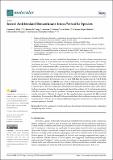Por favor, use este identificador para citar o enlazar a este item:
http://hdl.handle.net/10261/310206COMPARTIR / EXPORTAR:
 SHARE SHARE
 CORE
BASE CORE
BASE
|
|
| Visualizar otros formatos: MARC | Dublin Core | RDF | ORE | MODS | METS | DIDL | DATACITE | |

| Título: | Insect Antifeedant Benzofurans from Pericallis Species |
Autor: | Díaz, Carmen E. CSIC ORCID ; Fraga, Braulio M. CSIC; Portero, Adriana G.; Brito, Iván; López-Balboa, Carmen; Ruiz-Vásquez, Liliana; González-Coloma, Azucena CSIC ORCID | Palabras clave: | Pericallis Aerial parts Transformed roots Benzofurans Biotransformation Antifeedant Post-ingestive activity |
Fecha de publicación: | 18-ene-2023 | Editor: | Multidisciplinary Digital Publishing Institute | Citación: | Marine Drugs, 28(3), 975: 1-19 (2023) | Resumen: | In this work, we have studied the benzofurans of Pericallis echinata (aerial parts and transformed roots), P. steetzii (aerial parts and transformed roots), P. lanata (aerial parts), and P. murrayi (aerial parts and roots). This work has permitted the isolation of the new benzofurans 10-ethoxy-11-hydroxy-10,11-dihydroeuparin (10), (-)-eupachinin A ethyl ether (12), 11,15-didehydro-eupachinin A (13), 10,12-dihydroxy-11-angelyloxy-10,11-dihydroeuparin (14), 2,4-dihydroxy-5-formyl-acetophenone (15) isolated for the first time as a natural product, 11-angelyloxy-10,11-dihydroeuparin (16), and 12-angelyloxyeuparone (17), along with several known ones (1–9, 11). In addition, the incubation of the abundant component, 6-hydroxytremetone (1), with the fungus Mucor plumbeus has been studied. Benzofurans in the tremetone series (1, 1a, 2–5, 18, 18a), the euparin series (6, 7, 7a, 8–10, 14, 16), and the eupachinin-type (11, 12) were tested for antifeedant effects against the insect Spodoptera littoralis. The antifeedant compounds (1, 4, 6, 11, 12) were further tested for postingestive effects on S. littoralis larvae. The most antifeedant compounds were among the tremetone series, with 3-ethoxy-hydroxy-tremetone (4) being the strongest antifeedant. Glucosylation of 1 by its biotransformation with Mucor plumbeus gave inactive products. Among the euparin series, the dihydroxyangelate 14 was the most active, followed by euparin (6). The eupachinin-type compounds (11, 12) were both antifeedants. Compounds 4, 11, and 12 showed antifeedant effects without postingestive toxicity to orally dosed S. littoralis larvae. Euparin (6) had postingestive toxicity that was enhanced by the synergist piperonyl butoxide. | Versión del editor: | https://doi.org/10.3390/molecules28030975 | URI: | http://hdl.handle.net/10261/310206 | DOI: | 10.3390/molecules28030975 | E-ISSN: | 1660-3397 |
| Aparece en las colecciones: | (IPNA) Artículos (ICA) Artículos |
Ficheros en este ítem:
| Fichero | Descripción | Tamaño | Formato | |
|---|---|---|---|---|
| Insect-Diaz_et_al-2023-Molecules.pdf | Artículo principal | 1,27 MB | Adobe PDF |  Visualizar/Abrir |
CORE Recommender
SCOPUSTM
Citations
1
checked on 20-abr-2024
Page view(s)
32
checked on 28-abr-2024
Download(s)
34
checked on 28-abr-2024
Google ScholarTM
Check
Altmetric
Altmetric
Este item está licenciado bajo una Licencia Creative Commons



